Musicarta Modes - Supplement Three
Musicarta Easy Piano Style pieces as Modes
Most of the piano solos in the Musicarta Easy Piano Style (MEPS) workbook have modal chord sequences. You can listen to all the solos on the Mister Musicarta YouTube Musicarta Easy Piano Style playlist.
Here are short descriptions of the pieces with links to the Mister Musicarta YouTube performances. The web page for this module has the YouTube videos embedded for your studying convenience.
The purpose of this page is twofold – firstly, to offer more listening which is ‘certified 100% modal’ and thereby stimulate the readers interest in modes, and secondly to walk the reader through the process of establishing whether a chord sequence is in fact modal.
First Pair of Chords
The First Pair of Chords performance uses chords C and D minor, with C as the tonic. The chords are therefore I and ii and the piece is in the simple major, and doesn’t display modal harmony.
Second Pair of Chords
The Second Pair of Chords study also uses a pair of chords a whole tone apart (E minor and D), and with the upper, minor chord the tonic. The chords are therefore a i–ëVII pair, and the piece is therefore modal in its harmony. Both the Aeolian and Dorian modes have i–ëVII pairs, but the piece doesn’t have a subdominant (iv in the Aeolian, IV in the Dorian) so we are unable to say which mode definitively. The Aeolian mode is the more common minor mode however, so we would default to Aeolian for this piece.
One Fourth and a Pair
Here is the chord sequence for the One Fourth and a Pair study – The Vigil.

The piece starts with an A minor chord but ends on E minor, and listening to the piece should convince you that E minor is the home chord or tonic, and therefore i. Counting round our musical alphabet, we find we have a iv chord (A minor) and a ëVII chord (D major). The piece is therefore in the Aeolian mode – E Aeolian.
Three Fourths and a Pair
Here is the chord sequence for Three Fourths and a Pair.

The study starts and ends on A minor and a listen should convince you that this is indeed the home chord. Counting from A = i, we find our chord sequence is:
i v ëVI ëIII iv i ëVII i
The ëVI chord and the minor subdominant iv chord confirm that the study is in A Aeolian.
Tanza
Here is the Tanza chord sequence.

Look at the roots of the first line – A, G and F, all a whole tone apart, the highest of which is a minor chord. Only A minor, G and F chords on the all-white keys match that profile, so the first line is definitely in A Aeolian. The second line is the chord sequence from ‘Three Fourths and a Pair’, above, so the whole piece is in A Aeolian without a doubt.
Afternoon
Afternoon is pure diatonic major – ‘diatonic’ meaning, without any chromatic alterations to the key chords (no accidentals, in practical terms). It therefore uses only the i, ii, iii, IV, V and vi Ionian (pure major) chords. Listen to it for comparison with the modal tonalities you have been hearing.
Ever True
Here is the Ever True chord sequence.

Not much doubt that the piece is in A minor. A minor therefore = i, and the G and F chords will be ëVII and ëVI respectively – the i–ëVII–ëVI group of chords from the Aeolian One module.
Fanfare
Here is the chord sequence of Fanfare.

The A minor chord could have a claim to be the tonic of an A Aeolian piece here, but the fanfare eventually resolves to the major C chord, so the piece is in C major with the A minor emphasis used for colour.
An Unsettling Notion
These two lines of the Unsettling Notion chord sequence include all the chords used in the piece.

As the piece ends with four bars of A minor, we work on the assumption that that is the home chord/tonic – i. The other chords therefore line up ëVII (G), IV (D) and ëIII (C). The i–ëIII–IV–ëVII group of chords is a typical Dorian selection. Recall that the Dorian subdominant (‘Four’) chord is major (IV), while the Aeolian ‘Four’ is minor – iv.
MEPS Diary 29-06-13 (A Dilemma)
Here is the chord MEPS Diary 29-06-13 chord sequence.

The first line of this chord sequence should strike you forcible as an A Aeolian i–ëVII–ëVI group of chords. The only shadow of doubt is raised by the Dm7 chord – which is, of course, the F chord with the dropped submediant D bass, producing D minor 7.
MEPS Diary 12-11-13 – Riff in Sixths
Here is the riff chord sequence.

The Am–G pair of chords should immediately have you thinking “i-ëVII modal minor”, but then you come up against the Bë chord. If A minor is the tonic, Bë is ëII – a major chord built on a root just one semitone higher. Examining your knowledge of the chords built on and out of the C major scale tones – which we know will always be ‘modal’ - we find the E minor–F major pair fits the pattern. The riff could therefore conceivably be in the Locrian mode (E to E white keys and chords), but for the fact that the F natural will make the Locrian ‘flat seven’ chord minor – D minor in E Locrian. The flat seven chord here, however, is major (G - ëVII). The chord sequence is therefore not modal.
Naomi - Fantasie
Naomi – Fantasie is the showcase of the Musicarta Easy Piano Style album. Here is its chord sequence.
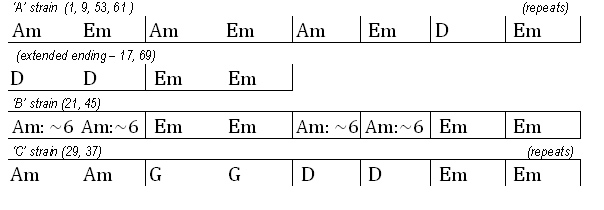
Repeated end-of-strain E minor chords give the key at least away – as E minor (= i). The absence of any B major chords (V, ‘Five’ – the principle cadencing chord of the classical minor key) suggest a modal tonality, and the D major chord before every tonic (ëVII acting as the cadencing chord) confirm it.
Other chords appearing are A minor (= iv) and G major (= ëIII). We do not need any more chords to establish the key as E Aeolian modal. Even the sixth added to the A minor chord in the B strain (an F sharp) stays in key.
|
OUT NOW! |
THE MUSICARTA BEAT & RHYTHM WORKBOOK At last! An effective approach to keyboard rhythm & syncopation skills. Learn more! |
ONLY $24.95! |
MODES |
The MusicartaA methodical approach to keyboard syncopation for
|
PUBLICATIONS
exciting keyboard
creativity courses
CHORDS 101
WORKBOOK

~HANON~
video course

Musicarta
Patreon
PENTATONICS
WORKBOOK
video course

Creative Keyboard
video course

BEAT AND RHYTHM
WORKBOOK
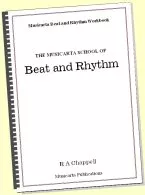
- Volume 1 -

12-BAR PIANO
STYLES WORKBOOK
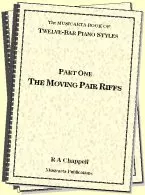
MUSICARTA MODES
WORKBOOK
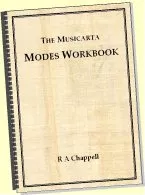
PIANO STYLE
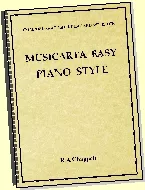
CANON PROJECT
video course
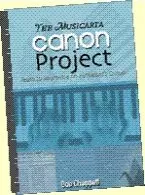
VARIATIONS
video course
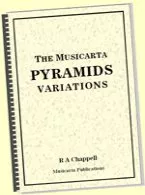
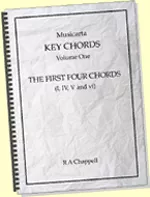
- Piano Solo -
video course
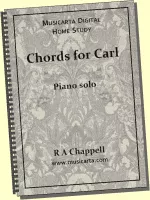
- Piano Solo -
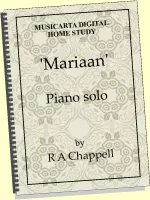

YouTube playlists





 THE LOGO
THE LOGO
